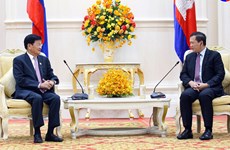Asian-Pacific countries coordinate in disaster prevention
Asian-Pacific countries have committed
to working closely together and coordinating their efforts in
preventing typhoons, floods and unpredictable weather events which
occur regularly throughout the region.
Asian-Pacific countries have committed
to working closely together and coordinating their efforts in
preventing typhoons, floods and unpredictable weather events which
occur regularly throughout the region.
This was one of the outcomes of the 42nd session of the UNESCAP/ WMO Typhoon Committee that has concluded in Singapore .
The United Nations Economic and Social Commission for Asia and the Pacific (UNESCAP) and the World Meteorological Organisation (WMO) said that typhoons continue to wreck havoc in many countries throughout the region. In 2009, 22 tropical cyclones formed over the Western North Pacific and the East Sea , 13 of which reached typhoon intensity. Three of them – Ketsana, Parma and Morakot – caused severe damage and losses in the Philippines , Cambodia , Vietnam , and Taiwan ( China ).
The warmer climate has reduced the number of tropical cyclones but increased their intensity in the region.
The Committee identified urban flood risk management as a key area for future work.
According to WMO statistics, the Asia-Pacific region is one of the most vulnerable to natural disasters. From 1950 to 2005, 54 percent of worldwide deaths caused by natural disasters – or approximately three million people – occurred in this region. Floods associated with typhoon-related impacts account for 57 percent – or approximately 33.5 billion USD – of the economic losses in the region during the same period.
UNESCAP, in collaboration with WMO, founded the Typhoon Committee in 1968. The founding members were Hong Kong ( China ), China , Japan , the Republic of Korea , Laos , the Philippines and Thailand .
The Committee has coordinated with its members to reduce the damage caused by typhoons and floods in the region by improving meteorological and hydrological facilities and launching programmes for training personnel in forecasting typhoons and other disasters./.
This was one of the outcomes of the 42nd session of the UNESCAP/ WMO Typhoon Committee that has concluded in Singapore .
The United Nations Economic and Social Commission for Asia and the Pacific (UNESCAP) and the World Meteorological Organisation (WMO) said that typhoons continue to wreck havoc in many countries throughout the region. In 2009, 22 tropical cyclones formed over the Western North Pacific and the East Sea , 13 of which reached typhoon intensity. Three of them – Ketsana, Parma and Morakot – caused severe damage and losses in the Philippines , Cambodia , Vietnam , and Taiwan ( China ).
The warmer climate has reduced the number of tropical cyclones but increased their intensity in the region.
The Committee identified urban flood risk management as a key area for future work.
According to WMO statistics, the Asia-Pacific region is one of the most vulnerable to natural disasters. From 1950 to 2005, 54 percent of worldwide deaths caused by natural disasters – or approximately three million people – occurred in this region. Floods associated with typhoon-related impacts account for 57 percent – or approximately 33.5 billion USD – of the economic losses in the region during the same period.
UNESCAP, in collaboration with WMO, founded the Typhoon Committee in 1968. The founding members were Hong Kong ( China ), China , Japan , the Republic of Korea , Laos , the Philippines and Thailand .
The Committee has coordinated with its members to reduce the damage caused by typhoons and floods in the region by improving meteorological and hydrological facilities and launching programmes for training personnel in forecasting typhoons and other disasters./.












